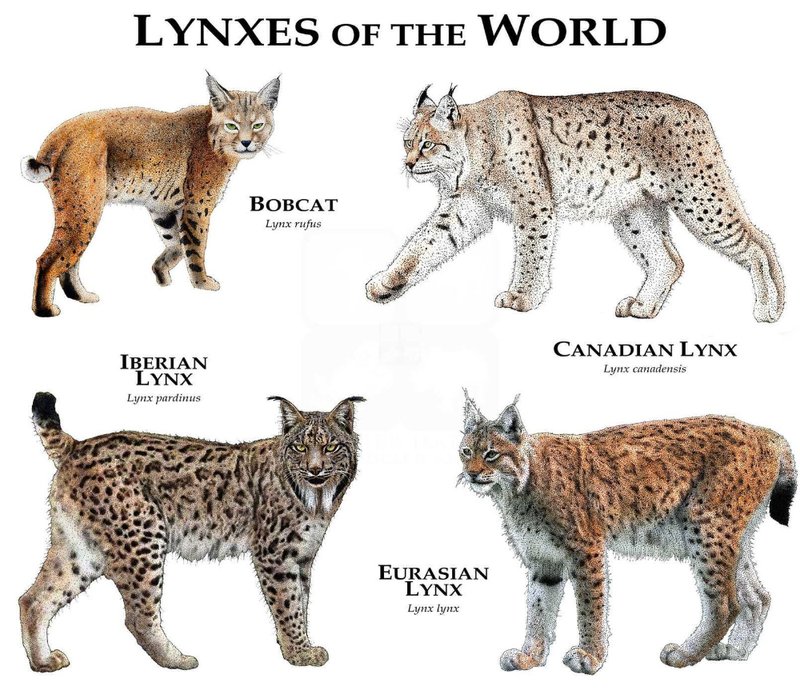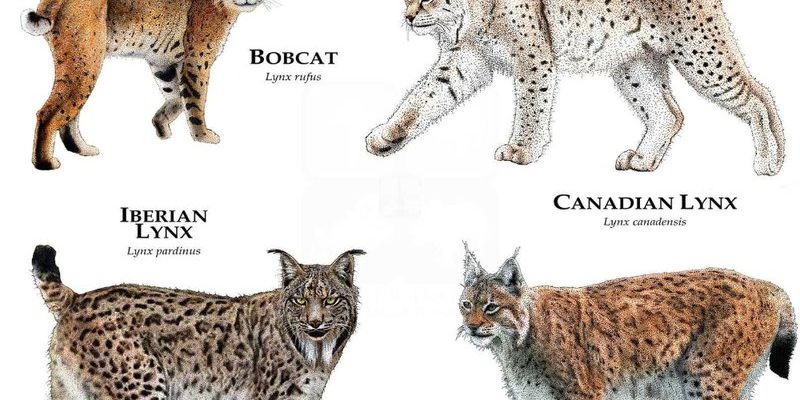
Many people might think the Iberian lynx is just another big cat, but it’s a bit special. With its tufted ears, spotted coat, and the iconic little beard under its chin, it’s like the rock star of the lynx family. Not to mention, its critically endangered status adds a layer of urgency to understanding and protecting these amazing creatures. So, whether you’re an amateur wildlife enthusiast or just curious about our furry friends, let’s explore 10 animals similar to the Iberian lynx, uncovering what makes each one unique.
1. Canadian Lynx
The Canadian lynx is one of the most similar animals to the Iberian lynx. Found in the forests of Canada and the northern United States, this lynx has similar features. Just like its Iberian cousin, it has those charming tufted ears, but you’ll notice it has longer legs and a fluffier coat, which helps it roam through snowy terrain.
The Canadian lynx primarily hunts snowshoe hares, so its diet reflects its environment. You might be wondering how to tell the two apart. While the Iberian lynx prefers open Mediterranean areas, the Canadian lynx thrives in dense forests. Moreover, the Canadian lynx is generally larger, weighing between 18-30 pounds, while the Iberian lynx is leaner at about 25 pounds.
2. Eurasian Lynx
Next up is the Eurasian lynx, the largest of its kind, found across Europe and Asia. This lynx sports a spotted coat, similar to the Iberian lynx, but its coloring is usually a bit more muted, often taking on a tawny hue. The Eurasian lynx is adaptable; it can thrive in various habitats, from snowy mountains to dense forests.
When comparing the two, size is a big factor. The Eurasian lynx can weigh up to 66 pounds, making it significantly larger than the Iberian lynx. Also, while the Iberian lynx has distinctive facial markings and a “beard,” the Eurasian lynx has less pronounced facial features, giving it a different aesthetic. So, if you see a lynx and it looks hefty and a little less fashionable, it might be your Eurasian friend!
3. Bobcat
You might have heard of the bobcat, a smaller relative of the lynx family found throughout North America. With its short tail and tufted ears, it shares some similarities with the Iberian lynx. Bobcats typically weigh between 15-35 pounds and are known for their adaptability to various environments.
Here’s the thing: although they resemble each other, bobcats are generally more robust and less spotted than the Iberian lynx. While the Iberian lynx is famous for its striking look, the bobcat sports a more muted, earthy tone. Plus, while the Iberian lynx is critically endangered, bobcats are fairly common and can easily be found in wooded areas, deserts, and even suburbs.
4. Serval
The serval is another interesting feline that shares some traits with the Iberian lynx. Native to Africa, the serval is known for its long legs, large ears, and spotted coat. Standing about 24-28 inches tall at the shoulders, it’s a bit taller than a domesticated cat but still smaller than a lynx.
What sets the serval apart is its incredible hunting ability. This cat is an expert at catching birds and small mammals, leaping up to 10 feet in the air to catch its prey. You might notice that the serval’s coat is more golden than the Iberian lynx’s coloring, and its spots are arranged differently, giving it a distinctive look. While the Iberian lynx is a conservation success story in the making, the serval is often found in the wild, thriving in its natural habitat.
5. Caracal
Another fascinating feline is the caracal, which also hails from Africa and parts of the Middle East. This medium-sized cat is known for its tufted ears—similar to the Iberian lynx, but the caracal is more robust and muscular. They can weigh between 20-40 pounds, showing that they are not to be underestimated in size.
Caracals have a sleek, short coat that is typically a reddish-brown color, which makes spotting them difficult in their natural habitat. Unlike the Iberian lynx, which prefers forested areas, caracals thrive in savannas and scrubland. Their hunting technique is impressive; they can leap high to capture birds mid-flight. Next time you see a cat with those striking ear tufts, you’ll know it’s a caracal, not a lynx!
6. Ocelot
The ocelot is a small wild cat native to the Americas and can easily be confused with the Iberian lynx due to its similarly patterned coat. Ocelots are typically smaller, weighing around 20-35 pounds, and feature striking rosettes and stripes across their coat, which can vary in color from light tan to dark brown.
One way to differentiate these two cats is by their habitat preferences. Ocelots thrive in tropical forests, wetlands, and grasslands, while the Iberian lynx is more adapted to scrublands and open areas in Southern Europe. If you spot a cat with unique spots in a lush green landscape, chances are it’s an ocelot making its home there.
7. Jungle Cat
The jungle cat is another feline that shares a few traits with the Iberian lynx. Found in South and Southeast Asia, this medium-sized wildcat has a long body and a short tail. It typically weighs around 15-35 pounds, making it similar in size to the Iberian lynx.
One of the distinct features of the jungle cat is its tan coat, which often has faint stripes and spots. They have a preference for wetland habitats, unlike the Iberian lynx, which prefers drier, open areas. Though they don’t have the same level of endangerment as the Iberian lynx, their habitat is shrinking, making awareness and conservation efforts important.
8. Asian Golden Cat
Lastly, the Asian golden cat is another animal to consider. Found in forests across Southeast Asia, this cat has a sleek, golden-brown coat that can also embody a variety of shades. It’s larger than the Iberian lynx, weighing anywhere from 20-50 pounds.
What’s interesting about the Asian golden cat is its elusive nature; it’s often difficult to spot in the wild. While both cats share a common diet, preying on similar small mammals, their habitats and conservation statuses differ greatly. The Asian golden cat faces threats from habitat loss and poaching, showing how similar cats can face unique challenges in their environments.
Exploring the family of felines similar to the Iberian lynx is both fascinating and enlightening. Each of these animals brings its unique characteristics and adaptations to the table, showing how diverse and intricate the feline world is. From the Canadian lynx to the ocelot, these cats might share certain traits, but they each have their own story to tell.
Understanding these animals helps us appreciate their role in the ecosystem and why conservation efforts are so important. The Iberian lynx may be the star of the show, but the supporting cast is just as important in the grand scheme of nature. Whether you’re a wildlife enthusiast or just a curious learner, these cats are worth knowing—and protecting.

